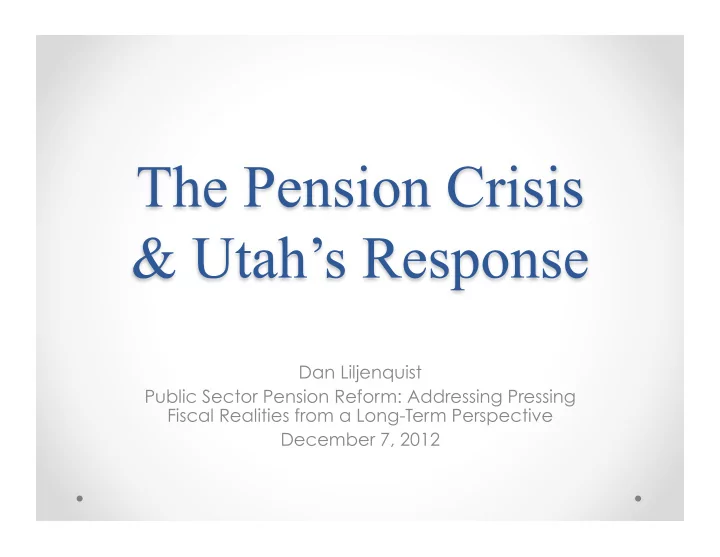

Dan Liljenquist Public Sector Pension Reform: Addressing Pressing Fiscal Realities from a Long-Term Perspective December 7, 2012
Investment Income (in Millions) $3,000 $2,000 $1,000 $0 -$1,000 -$2,000 -$3,000 -$4,000 2000 2001 2002 2003 2004 2005 2006 2007 2008 2 Source: Utah Retirement Systems Comprehensive Annual Financial Reports - 2000-2009 - for year ending Dec. 31
o What impact would the losses have on Utah’s budget now and in the future? o How would the losses impact employer contribution rates? o How long would it take for the pension system to recover? o Would the market recover the losses? o What would happen if Utah had another year like 2008? 3
o Forty year actuarial projections, with market returns of 6%, 7%, 7.75%, and 8.5% o Modeled scenarios included: o Standard option (increase contribution rates) o Do-Nothing option (freeze contribution rates at existing levels) o Delay options (freeze contribution rates for 3 or 5 years and then increase contribution rates) 4
Utah’s Projected Funded Ratio 100.8% 96.5% ? ? ? ? ? 2007 2008 2009 2010 2011 2012 2013 Source: Utah Retirement Systems Comprehensive Annual Financial Reports - 2000-2009 - for year ending Dec. 31; and 5 Memo to the Honorable Daniel R. Liljenquist, Senate Chair, from Gabriel Roeder Smith & Company, November 10, 2009
Utah’s Projected Funded Ratio 100.8% 96.5% 87.8% 85.8% 80.6% 75.1% 70.5% 2007 2008 2009 2010 2011 2012 2013 Source: Utah Retirement Systems Comprehensive Annual Financial Reports - 2000-2009 - for year ending Dec. 31; and 6 Memo to the Honorable Daniel R. Liljenquist, Senate Chair, from Gabriel Roeder Smith & Company, November 10, 2009
Utah’s Projected Employer Contribution Rates 15.4% 13.3% ? ? ? ? ? FY 2010 FY 2011 FY 2012 FY 2013 FY 2014 FY 2015 FY 2016 Source: Utah Retirement Systems Comprehensive Annual Financial Reports - 2000-2009 - for year ending Dec. 31; and 7 Memo to the Honorable Daniel R. Liljenquist, Senate Chair, from Gabriel Roeder Smith & Company, November 10, 2009
Utah’s Projected Actuarial Required Contribution Rates 23.1% 22.8% 20.6% 18.2% 16.2% 15.4% 13.3% FY 2010 FY 2011 FY 2012 FY 2013 FY 2014 FY 2015 FY 2016 Source: Utah Retirement Systems Comprehensive Annual Financial Reports - 2000-2009 - for year ending Dec. 31; and 8 Memo to the Honorable Daniel R. Liljenquist, Senate Chair, from Gabriel Roeder Smith & Company, November 10, 2009
9
Utah’s Projected Funded Ratio with Employer Contributions Frozen at 2010 Rates 100% 8.5% Return 7.75% Return 80% 7% Return 60% 6% Return 40% 20% FY FY FY FY FY FY FY FY FY FY FY FY FY 2010 2011 2012 2013 2014 2015 2020 2025 2030 2035 2040 2045 2050 Source: Utah Retirement Systems Comprehensive Annual Financial Reports - 2000-2009 - for year ending Dec. 31; and 10 Memo to the Honorable Daniel R. Liljenquist, Senate Chair, from Gabriel Roeder Smith & Company, November 10, 2009
o First, you have to contain the situation o Second, you have to work over time to clean things up
o Approximately 8,000 teachers kept out of classrooms for 25 years o 100% of public education growth for the next five years, increasing class sizes by up to 8 children per class o Increased contributions will equate to 19% of current state public education funding
Pension Costs 14
15
Existing defined benefit programs closed to new enrollees on June 30, 2011 Employer contributions to new retirement program capped by statute at 10% of base salary New employees can choose between: (1) a straight 401(k) plan, or (2) a hybrid pension / 401(k) plan 16
Recommend
More recommend